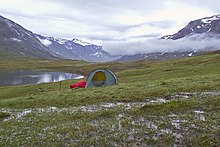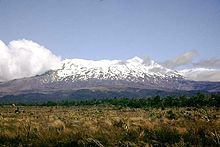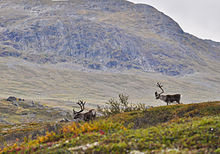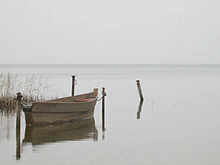National park
![]()
National Park is a redirect to this article. For other meanings, see National Park (disambiguation).
![]()
This article or section is still missing the following important information:
The article so far only covers national parks on land. Thus, all information on marine protected areas with national park status, i.e. Marine National Parks, is missing.
Help Wikipedia by researching and adding them.
A national park is an extensive protected area, usually subject only to natural development and protected by special measures from unwanted human interference and pollution. As a rule, these are areas that are particularly valuable ecologically or of outstanding scenic appeal and are managed on behalf of a government. They are often also used as recreational areas and for soft tourism. The definition of a national park is not the same in all states. Nevertheless, there is a common idea: the preservation of large natural areas, unaltered by human intervention, for posterity and as a symbol of national pride.

Teide National Park (Spain) is one of the most visited in Europe.

The Sarek National Park in Sweden is Europe's oldest - and still one of the largest.
History
The idea of placing particularly fascinating wilderness areas under protection arose in the early 19th century. The English poet William Wordsworth called for this in 1810, as did the American painter George Catlin in 1832 and the Swedish baron Adolf Erik Nordenskiöld in 1880. The original idea was to preserve the wonders of nature so that future generations could also enjoy them and relax here. In 1864, at the instigation of conservationist John Muir, the first protected area was defined - in what is now Yosemite National Park (California) - but it was not until 1906 that it was incorporated into the nascent National Park System. The first national park was established in 1872 with Yellowstone National Park, also in the USA. Unlike the Yosemite Conservation Area, Yellowstone National Park was not under the responsibility of the state, but directly under the U.S. government. In 1916, the National Park Service was created as an independent agency of the Department of the Interior.
The countries of Canada, Australia and New Zealand soon followed suit with the establishment of national parks, as there were still large areas of (apparently) untouched nature that could be protected relatively easily. In 1879 Australia founded the Royal National Park, in 1887 Canada the Banff National Park (then called Rocky Mountain National Park) and New Zealand in the same year the Tongariro National Park.
All of these countries were inhabited by indigenous peoples before colonization by Europeans, whose influence on most landscapes was quite formative for centuries - even in the most sparsely populated regions. However, this fact was ignored when national parks were established in many countries until the end of the 20th century: In the vast majority of cases, the prohibition of use associated with national park establishment extended to the traditional "ecosystem people" living there. Not infrequently, they were even expelled from their ancestral land in the course of the protection. Such concepts are based on the idea that human activity is fundamentally harmful to nature. It is only since the beginning of the 21st century that local communities - not least due to their own commitment - have increasingly been included in protected area concepts as "natural elements" of the landscape.
In Europe, the first national parks were established in Sweden in 1909 and in Switzerland in 1914. Especially after the Second World War, the national park idea became established and today there are more than 2,200 national parks in about 120 countries. The scenic diversity of the areas is enormous and includes almost all landscape types.
The history of the Royal National Park in Australia is interesting. With an area of 154.42 km², it is mostly located in the urban area of the megacity Sydney and is the second oldest national park in the world. It was unceremoniously established in 1879 for economic reasons after coal deposits were discovered in the area and politically influential outback mine owners feared competition at the city's gates. In this way, a jewel of largely untouched nature was preserved.
In German, the terms Naturdenkmal (natural monument) and Naturschutzgebiet (nature reserve) were common since the beginning of the 20th century. The term national park only became established in the 1970s. Initially, it was more about national importance and less about the criteria in the sense of the IUCN.
Today, nature conservation worldwide is coordinated by the IUCN. Every ten years, the IUCN organises an international congress (World Parks Congress) at which strategies for nature conservation in national parks are defined. The last congress took place in Sydney in 2014.

Ruapehu Volcano in Tongariro National Park

In contrast to non-European countries, the first national parks in northern Sweden took at least partial account of the rights of indigenous peoples (Saami reindeer in Abisko National Park).

Lake Pleschchejewo in Russia, National Park since 1988
IUCN Category: National Park
Definition
The International Union for Conservation of Nature and Natural Resources (IUCN) uses a system, introduced in 1978 and revised in 1994, in which national parks form category II protected areas.
"Category II protected areas are large natural or near-natural areas set aside to protect large-scale ecological processes, along with the complement of species and ecosystems characteristic of the area, which also provide a foundation for environmentally and culturally compatible, spiritual, scientific, educational, recreational, and visitor opportunities."
"Protected areas, which are intended to provide long-term protection for extensive natural areas together with the species and ecosystems that occur there. These should also be available - in an environmentally sound manner and with local acceptance - for spiritual needs, science, research and education, and for local recreation and sightseeing."
According to this definition, national parks are natural areas on water or land that are designated,
- to protect the integrity of one or more ecosystems and preserve them for present and future generations.
- to prevent exploitation as well as other activities that cause harm to the area.
- to provide a base for spirituality, research, education, recreation and visitation that is ecologically and culturally compatible.
Measures
As with all IUCN categories, the focus of the classification is on the design of the conservation objective and management (measures of interventions and prohibitions): For the recognition of a national park, the IUCN generally requires that nature is left to its own devices on 75% of the area. Exceptions are possible and regulatory interventions are also permitted locally if this is necessary, according to scientific research and monitoring, to maximise biodiversity or to favour rarer species. This is how a national park differs from a total reserve.
Examples of measures in national parks:
- Game population management
- Preservation of cultural landscapes (meadows that would develop into forests without ongoing maintenance)
- Elimination of introduced alien species
- Reintroduction of locally extinct species
- Alteration of water bodies to prevent siltation or to restore them to a more natural state (if they were impacted by humans prior to the establishment of the National Park).
The targeted interventions in nature are considered necessary to restore and, if necessary, maintain the ecological balance that has been disturbed by man. Measures to maintain the balance are necessary if the ecosystem has been significantly altered by humans (eradication of large predators or alteration of the salinity of a lake) and this alteration cannot be reversed. Other interventions are intended to preserve a diversity of biotopes and to save rare or endangered species by artificially improving conditions. On up to 25% of the area of a national park, economic use is even permitted (hunting, fishing, agriculture, removal of firewood). Unlike a nature park or landscape conservation area, however, the needs of nature rather than those of people take priority in a national park.
Distinction from national definitions
The management-oriented concept of the IUCN Category II National Park has little to do with the national park in the designations of the federal states, although many - especially more recent - definitions under federal state law are based on the IUCN specifications.
Examples of the differences:
- Swiss National Park, Switzerland: IUCN Ia Strict Nature Reserve
- Everglades National Park, USA: IUCN Ib Wilderness Area
- Białowieża National Park, Poland: IUCN II National Park (National Park)
- Victoria Falls National Park, Zimbabwe: IUCN III National Monument
- Vitosha National Park, Bulgaria: IUCN IV Habitat Management Area
- New Forest National Park, United Kingdom: IUCN V Protected Landscape
- Etniko Ygrotopiko Parko Delta Evrou, Greece: IUCN VI Managed Resource Protected Area
In some states, the class of national parks even includes primarily monument protection aspects, i.e. architectural objects to which landscape protection for the surrounding area is added in the manner of a natural park.
Questions and Answers
Q: What is a national park?
A: A national park is an area of land recognized and protected by a government to preserve the land or animals within it.
Q: What is the first national park in the world and when was it established?
A: The first national park in the world is Yellowstone National Park, established in 1872 in the United States.
Q: Who proposed the idea of protecting areas from human development?
A: American painter George Catlin proposed the idea of protecting areas from human development during the 1830s.
Q: What is the International Union for Conservation of Nature (IUCN)?
A: The International Union for Conservation of Nature (IUCN) is an international organization that defines and categorizes protected areas, including national parks.
Q: How does the IUCN define national parks?
A: The IUCN defines national parks as its category II type of protected areas.
Q: What is the largest national park in the world meeting the IUCN definition?
A: The Northeast Greenland National Park, which was established in 1974, is the largest national park in the world meeting the IUCN definition.
Q: How many national parks are there worldwide according to the IUCN?
A: According to the IUCN, there are approximately 7000 national parks worldwide as of 2010.
Search within the encyclopedia